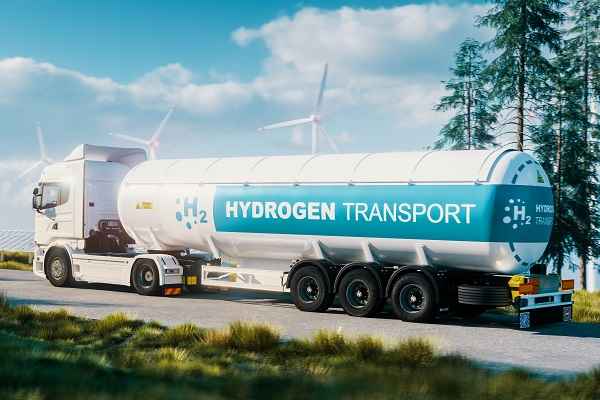 Behind Closed Doors: Corruption Uncovered in Delhi Metro's Top Management
Behind Closed Doors: Corruption Uncovered in Delhi Metro's Top Management IndiGo to launch Urban Electric Air Taxis between Delhi to Gurugram
IndiGo to launch Urban Electric Air Taxis between Delhi to Gurugram Swisspod secures Strategic Investment to advance the Hyperloop Transportation
Swisspod secures Strategic Investment to advance the Hyperloop Transportation Siemens Mobility revolutionizes Copenhagen's S-bane Network with Driverless Technology
Siemens Mobility revolutionizes Copenhagen's S-bane Network with Driverless Technology Unlocking prosperity between India and Myanmar: The Kaladan Multi-Modal Transit Project
Unlocking prosperity between India and Myanmar: The Kaladan Multi-Modal Transit Project Is the RRTS Truly Accessible to the Common Man or Only the Privileged?
Is the RRTS Truly Accessible to the Common Man or Only the Privileged? Alstom sold its Rail Signalling Technology Business to Knorr-Bremse for €630 million
Alstom sold its Rail Signalling Technology Business to Knorr-Bremse for €630 million Vensa Infrastructure wins ₹412.58 crore civil contract for Hisar Airport
Vensa Infrastructure wins ₹412.58 crore civil contract for Hisar Airport Kuala Lumpur-Singapore high-speed rail project cost could be slashed to RM70 Billion
Kuala Lumpur-Singapore high-speed rail project cost could be slashed to RM70 Billion Nevomo's MagRail Technology Selected for Hyperloop Freight Demonstrator
Nevomo's MagRail Technology Selected for Hyperloop Freight Demonstrator
Green Hydrogen: Opportunities and Challenges for India

India is witnessing an unprecedented rise in fuel prices since June 2021. This has brought the matter of energy security back on the discussion table. The discussion’s central theme has been ever-increasing fuel demand and dependency on imported crude oil for domestic needs. India’s annual energy import cost is in excess of USD 123 billion in 2019. More than 82% of this cost is consumed in importing crude oil and natural gas. Solar PV and wind have revolutionized India’s green energy story in the past decade. Once struggling to meet the peak electricity demand, the country now has a surplus power scenario. Indian Energy Exchange reported that the availability of sell-bids for the day-ahead market in its system is twice that of demand.
Diversification of electricity sources by integrating renewable energy in its grid is helping India in achieving the Paris agreement targets. The country has pledged to achieve 40% installed capacity from renewable energy sources by 2030 and reduce emissions intensity by 33-35% below 2005 levels in its nationally determined commitments to the 2015 Paris agreement.
While renewable energy is undoubtedly a better option than present fossil fuel-based energy, it is not a one-stop solution for all our energy problems. Renewable technology is recommended but not a sufficient measure to achieve goals as envisaged in the Paris Agreement. Moreover, electricity comprises only around 16.5% of the final energy consumption at the national level. Additional efforts are required to reduce greenhouse gasses (GHG) emitted by the remaining 83.5% energy sector.
The goal post of environment-friendly development has changed from merely reducing GHG emissions to achieving net-zero emissions. Net-zero energy systems are emerging as a sustainable solution to topical energy problems. At least 12 countries have already legislated net-zero emission targets, and 41 more countries are in the process of doing the same. Over the past few years, green hydrogen has emerged as a ‘game-changer (at least theoretically) and become the latest buzzword in the area among net-zero energy experts.
Hydrogen: Sunrise Sector
Hydrogen is seen as a sunrise technology for achieving net-zero emission targets as it does not emit GHG upon combustion. Its inherent chemical characteristics, multiple end-uses, and harmony with other fuel and energy carriers make it a strong contender of the clean energy transition apart from electrification, battery storage systems, carbon, capture, utilization, and storage (CCUS), bioenergy, etc.
At present, hydrogen is being primarily produced with the help of fossil fuels for use in the chemical, steel, and refinery industry. Today, it is possible to produce hydrogen with the help of renewable energy-based electricity. The ‘net-zeroness’ of hydrogen depends on the method of production. Steam Methane Reforming (SMR) incurs a measurable amount of emissions when used for producing hydrogen (Hydrogen produced with such process is called gray hydrogen). Green hydrogen (made from water and green electricity using electrolyzer) is considered the next big movement toward sustainable development. It has found relevance in today’s energy policy narrative, given its ability to decarbonize ‘hard-to-abate’ industries. Hard-to-abate sectors (like the steel industry) require a significant investment of green technology than existing carbon-based technologies.
Countries with net-zero emission targets have been exploring ways to augment the usage of green hydrogen in their economy for decades due to the absence of technological dominance by single or group of countries and broader geographical availability of primary resources such as renewable energy, water contrary to the fossil fuels are concentrated in the specific geographic area.
The reduction in the cost of renewable electricity has fueled the ‘green hydrogen hope.’ Interestingly, this is not the first time hydrogen is being projected to solve contemporary energy issues. Historically, hydrogen was first included as a part of energy policy in the 1970s after the oil embargo, but new discoveries of oil reserves damped out the efforts in subsequent decades. Although it was perceived as a solution to climate change on two separate occasions; once in the 1990s and again in the 2000s, the low oil prices, economic and financial crisis, and popularity of alternative renewable technologies like solar PV and wind affected the concrete financial support required for its development. Today, high technology costs, lack of adequate international supply chain, and lack of awareness impact the commercialization, infrastructure development, and demand creation of hydrogen-based technology.
The India Story
India’s endeavor in hydrogen technologies dates back to 1976, when the Department of Science and Technology sponsored hydrogen projects in universities and technical institutes. At present, India produces around 6.7 Mt of hydrogen annually. A report published by The Energy and Resources Institute anticipates the demand to reach 23 Mt in 2050. The current price of hydrogen in the country ranges from INR 340 to 400 per kg. (USD 4.5 to 5.3 per kg). The cost parity is expected to be achieved when green hydrogen is produced at INR 150 per kg (USD 2 per kg). Refineries, fertilizer, and the steel industry are major consumers of hydrogen in the country. Apart from industries, active research, development, and demonstration is being carried out in the area of electricity production, hydrogen storage, and mobility (fuel cell powered cars, rail, truck, bus, ships).
High technology cost, risk of undesirable sunk cost, absence of dedicated government policy, and lack of public awareness have been significant barriers in front of India’s hydrogen economy. However, the recent policy developments portray India’s serious intentions in transitioning towards green hydrogen in the long term.
India’s government has proposed spending INR 800 Cr by 2024 in its Union budget for FY 2021-22. It mentions pilot projects, infrastructure and supply chain, research and development, and regulations and public outreach as core focus areas. Ministry of New and Renewable Energy (MNRE) is planning to launch a policy document for the national hydrogen energy mission, which will act as a primer for the development of the hydrogen ecosystem in the country, and the rationale of the government to be aggressive in green hydrogen development seems to be prudent.
Opportunities and Challenges
It is quite challenging to integrate renewables in the electric grid beyond a point without technological intervention. Higher penetration might result in the duck curve phenomenon, first observed in California, USA. In the duck curve phenomenon, renewable electricity production and peak demand are displaced by hours on a daily load curve. Green hydrogen, in conjunction with grid-scale battery storage, can act as a solution to this problem. Such a solution will reduce renewable energy curtailment, allow maximum utilization of renewable energy sources, entrust and protect RE investments against loss of revenue due to curtailment, provide power system operation flexibility, and allow additional capacity for more renewable plants in the electric grid.
India has discovered one of the lowest solar PV generation costs globally through a reverse auction mechanism. While the country’s lowest cost of solar PV generation stands at INR 1.99 per kWh, most of the projects are being installed in the range of INR 2.5 to 4 per kWh.
According to International Renewable Energy Agency’s report, reducing the cost of renewable-based electricity by half can halve the Levelized cost of green hydrogen if other cost components (capital cost, annual load factor of electrolyzer) remain unchanged.
India has the potential to bring down the cost of green hydrogen by using low-cost renewable generating plants and cost-curtailment experience gained through solar and wind reverse auctions. Huge market potential, owing to the young demography and thriving economy, will be a long-term benefit for the government while pushing the application of hydrogen-based technologies.
Hydrogen needs to be considered as complementary to its alternatives rather than contemplating it as an ultimate and stand-alone solution as it comes with its own constraints. The present storage and transportation technologies are expected to be mature and cost-effective by 2030. Hence, the production and near-real-time utilization of hydrogen at the same location can be promoted to safeguard investments against undesirable sunk costs.
Production of green hydrogen requires water and green electricity as input to the electrolyzer. Each kg of hydrogen uses around 8.92 liters of demineralized water. The availability of sufficient water streams is critical as it is a valuable and limited resource having multiple application areas. Desalination plants can be set up to process wastewater or seawater for electrolysis to avoid possible water usage conflicts. Freshwater from such desalination plants can also be provided to the local population if the plants are set up in water scares regions. Green hydrogen as an energy sector can become a reality in India if the large availability of renewable and water resources are used optimally.
The Way Forward
Renewables have been torchbearers of the green initiative since the beginning of the 21 st century. Hydrogen can play the same role by the mid-century as the goalpost of going green shifts from merely reducing GHG emissions to achieving net-zero emissions. The success of government initiatives lies in administering the right mix of intra and inter-sectoral policies. It is undoubtedly clear that policymakers’ decisions today will have a long-lasting impact on the country’s energy story. The wish and will by the government, in conjunction with stable and sustained policies instead of stop-go policies, ensure an expedited as well as smooth transition towards the green hydrogen ecosystem. India’s immediate policy announcements will set the context for the role of hydrogen in its energy transition amid ongoing hype and hope around it.
This article is co-authored by Manoj Kumar Upadhyay, Deputy Advisor, NITI Aayog and Pratik Joshi, PhD Scholar Centre for Policy Studies, IIT Bombay. Views expressed are their own and not necessarily that of Urban Transport News.
(First appeared at FE Online)




